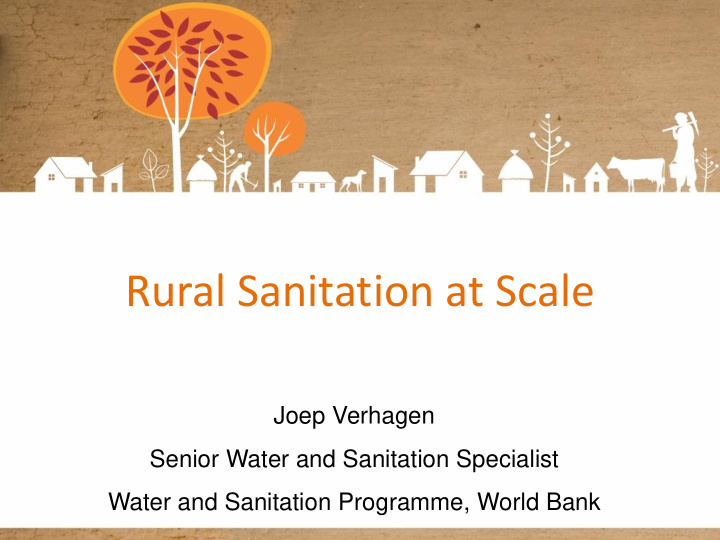



Rural Sanitation at Scale Joep Verhagen Senior Water and Sanitation Specialist Water and Sanitation Programme, World Bank
National sanitation GNP growth rates: coverage: India is sixth of India is second of these 7 Rural Sanitation in these seven (JMP data) and 10 th highest in the and amongst the bottom world 25 globally India 100 12.00 1990 Predominantly a rural problem YR1990 2010 and a poverty problem. YR2010 10.00 • 93% OD in rural areas • Coverage lowest quintiles is 8.00 6%. 50 6.00 Impacts health and economic development 4.00 2.00 • Loss 6.4% of Gross Domestic Product or INR 2.4 trillion in 0 2006 1 . 0.00 • Strong evidence emerging on the links between poor sanitation and stunting. Source: (1) WSP 2010: “The Economic Impacts of Inadequate Sanitation in India” and (2) Lamba, S and Spears, D. 2013 “Effects of Early -Life Exposure to Sanitation on Childhood Cognitive Skills: Evidence from India's Total Sanitation Campaign”. World Bank Policy Research Working Paper, WPS6659, October 2013 Knowledge Sharing Forum What works at scale? Distilling critical success factors for scaling-up rural sanitation
The Case of Thailand 100 95 Stronger 90 % Household Toile government rural 85 sanitation sector 80 75 enabling 70 environment 65 60 55 50 4.2% increase per 45 2.7% increase per year 40 year 35 30 25 20 15 10 5 0 1959 1961 1963 1965 1967 1969 1971 1973 1975 1977 1979 1981 1983 1985 1987 1989 1991 1993 1995 1997 1999 2001 2003 2005 Year Access to Rural Sanitation in Thailand 1959-2005 Source: Eddy Perez (WSP) Government of Thailand
WikiPedia: Maha Kumbh Mela and probably the largest human gathering on a single day. Over 30 million people were gathered. Knowledge Sharing Forum What works at scale? Distilling critical success factors for scaling-up rural sanitation
Emerging Headlines Leadership by National and State level governments; ownership of local government A systems approach Based on 6 years of learning in 13 countries
Access to does not equal use of latrines source: WASHCost – sample of 107 village in Andhra Pradesh
Framework for scaling-up Generate Strengthen Demand for Enabling Improved Environment Sanitation Strengthen Learning and Supply Knowledge
From Framework to Action : Changing Behaviors First to Stop Open Defecation and Create Demand for Moving Up the Sanitation Ladder Formative Research, Mass Media, Community Events, Household visits Facilitator triggering Community Ignition
Sanitation Marketing • Promotion • Product • Price • Place Using consumer research to segment populations to better reach the poor and other marginalized groups
Roles Government National and State Governments Local Government • • Create an enabling environment Ensure (not provide) sustainable sanitation services: • Policy, Strategy, Direction; • Institutional arrangements; Strategy and planning, advocacy Programme methodology; and promotion, capacity building, Implementation capacity; supervision, m&e, regulation Products and tools; Financing and incentives; Cost-effective implementation; Monitoring and evaluation
Cross-cutting success factors • Research Informed Behavior Change • Understanding and Designing for Market Segments and Behavioral Determinants • Real Time Results Based Monitoring • Use Evidence to Improve Service Delivery
THANKS Joep Verhagen
Recommend
More recommend